Updated for 2021
Leading retailers have made great strides in becoming omnichannel experts. Reaching consumers across multiple channels, having a strong digital presence, engaging on social platforms, and embracing mobile continue to be key themes in targeting today’s shopper.
However, being present across a myriad of channels is no longer enough to entice consumers who expect more from brands. Consumers want and demand personalized communications if they are to give up their hard-earned dollars.
When shutdowns from the pandemic were at their height last year, consumers needed to rethink their shopping habits and how they made purchase decisions. In a report by McKinsey, 40 percent of respondents across four countries said they tried new brands or made purchases with a new retailer. (McKinsey) This was especially prevalent in the U.S., with 46% of shoppers trying new brands or retailers.
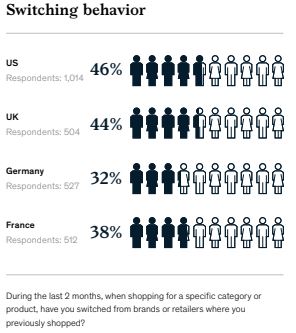
Many reasons contributed to this shift in loyalty such as lower prices, unavailability of certain items, convenience and more. While some of these factors are outside of a brand’s control, there are actions brands can take to compete in this new normal including offering a compelling, hyper-personalized customer experience.
Provide a Rich and Personalized Customer Experience
Not surprisingly, when consumers are browsing online, they want to see products displayed with multiple images and clear descriptions, as well as product reviews and an easy-to-navigate site. In McKinsey’s research, 56% of U.S. consumers rated clear descriptions and images as a top priority (June 2020). This was followed by a fast-loading site (53%), product reviews (45%) and easy navigation (42%).
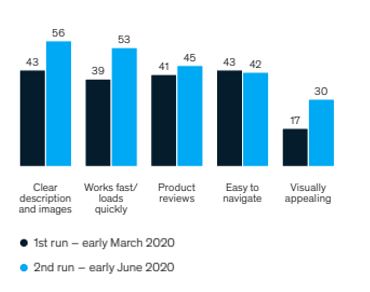
Factors that consumers look for in the online purchase experience include free and fast. For U.S. consumers, by far the most important factor is free delivery and return (65%). Other contributing elements to a positive experience include fast delivery (41%), loyalty card offers (28%) and fast check-out (27%).
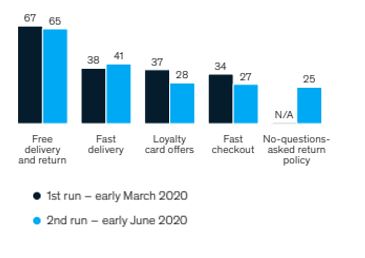
In a time when consumers are eager to try new brands, brands must put their best foot forward to create rewarding digital experiences for shoppers. While many brands are using the same tactics to attract shoppers, now so more than ever, personalizing the customer experience to deliver relevant offers and promotions can truly differentiate brands. In fact, 12-21% of survey respondents said they switched to brands that sent them relevant messages or promotions in their preferred channel.
In a data-driven age, consumers have come to expect this level of personalization and that brands know their preferences and interests.
- 91% of consumers say they are more likely to shop with brands that provide offers and recommendations that are relevant to them.
- 80% of consumers are more likely to make a purchase from a brand that provides personalized experiences.
- 90% of U.S. consumers find marketing personalization very or somewhat appealing.
- 72% of consumers say they only engage with personalized messaging.
- 80% of frequent shoppers only shop with brands that personalize the experience.
- 56% of online shoppers are more likely to return to a website that recommends products.
Driving this level of personalization requires data – and lots of it. Retailers must understand who their customers and prospects are beyond just name and email address. What do they like and dislike? What channels do they prefer to use? What have they recently purchased, added to a shopping cart, or browsed for online? How old are they? Are they married, have children, rent or own their home?
Econsultancy found that only 19% percent of brands use personalization in their marketing, even though 74% of marketers state they know it improves customer engagement. While collecting and analyzing this much data may seem like an overwhelming task, retailers who don’t take the time to gather multiple points of consumer information will quickly fall behind. Consumers will instead purchase from the competition – those who do provide the experience they are seeking, even if the price is higher.
So what types of data should you be collecting and how can you use it to drive a more personalized experience?
Begin with Your First-Party Data
Retailers are already gathering data from consumers. A report by Signal and Econsultancy revealed that 81% of marketers exhibiting strong ROI are making good use of their first-party data. This includes information such as purchase history, name and address, phone number, or other similar types of information that are collected as a direct result of a retailer’s interactions with a customer or prospect.
First-party data can be collected from a variety of sources. In a study by eMarketer, senior marketers stated the following top three sources: websites (70%), Point-of-Sales (POS)/CRM systems (63%), and email (61%).
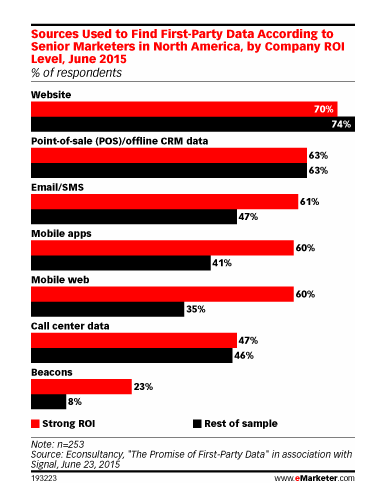
Making sense of this data can be somewhat puzzling if it isn’t integrated into a single database. Having bits of information stored in a billing system and other pieces of information in a contact management system will be of no use unless this data comes together to form a holistic view of who your customers are. Imagine each piece of data as a puzzle piece and when each new piece is fit together, the complete picture of the consumer begins to make sense.
Third-Party Data
Third-party audience data includes insights and data elements such as email addresses, phone numbers, demographics, lifestyle information, or behavioral data. Third-party data allows marketers to “complete the puzzle” and fill in the missing pieces of information to know consumers at a much deeper level.
While third-party data has been around for some time, the breadth and depth of today’s data far surpasses the days of simply acquiring a stagnant list from a broker. When third-party data was discussed in the past, there has always been much controversy about the accuracy and freshness of the data source. True, there are still plenty of list brokers who do not take measures to maintain a high-quality source of marketing data. However, data today can now be collected quickly, cleansed and delivered to a marketer on a daily basis.
In Merkle’s 2020 “Customer Engagement Report”, statistics show that according to most marketers (41%), it’s both first- and third-party data that is driving personalization efforts. A total of 46% of U.S.-based marketers rely on both first- and third-party data equally. Just 35% of U.S.-based marketers solely utilize first-party data.
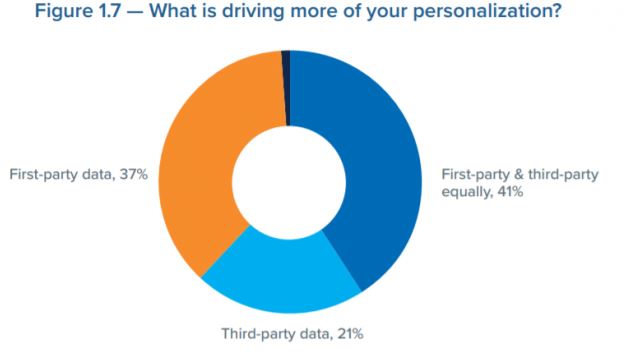
Data Integration & Automated Journey Management
Now that you have collected the data, it’s time to put it to work. Marketers must have a single version of the truth to create messages and offers that will resonate with their target audience. In MyBuy’s Personalization Consumer Survey, consumers purchase more from brands who:
- 53% – Suggest products based on browsing or buying behavior
- 49% – Personalize online ads that promote offers and products
- 48% – Send personalized emails based on past browsing and buying behavior
- 48% – Personalize the shopping experience across all channels
Delivering this level of personalization requires that consumer data is connected at a very granular level. Consider using a customer data platform for rapid data integration from both offline and online sources, including fast, real-time behavioral insights. With a consistent, customer view in place, marketers can provide better experiences and personalization to consumers.
The data stored in a CDP can connect to multiple other systems. Real-time integrations with other digital technologies you may already have in your martech stack make it easy to unify, manage and schedule data flows for any channel.
In addition, some CDPs also offer built-in journey management. Today’s empowered customers, choose their path and view the entirety of the experience with your brand across all touchpoints as one connected experience. Your customers interact with you across multiple touchpoints, across channels, and at the time of their choosing. However, an effective customer journey management program helps you eliminate any disruption in the customer purchase process to keep them seamlessly moving to conversion.
Data and technology can fuel great customer connections for retailers. It is the key to delivering the personalized experiences your customers are demanding, which in turn, will drive a huge competitive advantage.
Learn how Porch Group Media can help you get your data in order to better understand your customers and reach them across channels to boost your marketing success. Contact us to get started!


